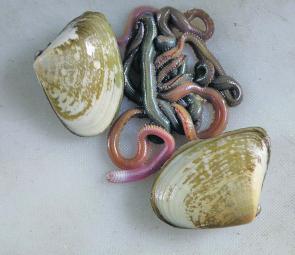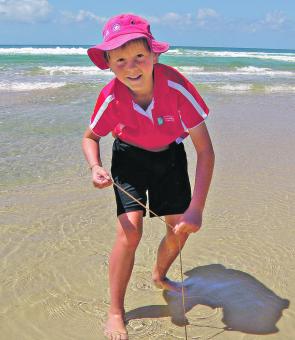For the first report of 2012 it’s helpful to map out monthly expectations of what might unfold in this fishing year.
The weather gurus tell us to expect a summer with heavy rain and more wild weather, though possibly not as severe as last year. By now we should be starting to see this eventuate.
Beach prospects for the first three months are certainly going to be at the mercy of the weather, but in the periods of good conditions, there is every reason to expect the gutters to hold dart and hopefully whiting and bream. Around the headlands, there should be bream, tarwhine and reef species.
Hopefully by April conditions might start to settle down. Last April heavy weather continued to make life difficult on the eastern beach. In such conditions it might be worth the trip to the Western Beach, provided that beach is clear of weed.
It is usual for weed to build up here in the last months of the year. Then in the first months of the new year it starts to disperse. Before making the effort to cross the island, it is a good idea to pick up some up-to-date local information about weed conditions, and also the condition of the tracks.
In late 2011 the Moon Point road was still closed it looked like it would stay that way for some time. The Woralie road was open but there were many rough and soft patches.
May, June and July are usually beautiful months to be on the island, even though we can still expect those bursts of strong south easterlies. As well as the reliable dart, we can expect bream and tarwhine to become more plentiful in the gutters and around the coffee rocks. We might even see the first of the annual tailor run, but as was seen last year, early fish are usually small.
By August the tailor season should be well established and continue through to late October. That brings us through to the last months of the year when there will still be a few tailor with the usual assortment of dart, bream and whiting.
Anglers on the eastern beach of Fraser Island predominantly use bait, with relatively few using metal lures and plastics. I must admit to being in the majority group, with the exception of tailor, for which I almost exclusively spin with metals like Spanyid Raiders in 65g and 85g. I have also persevered with a variety of plastics and have had some success taking big dart on tiny lime green grubs.
Taking a look at some of the bait options, the first that comes to mind is the West Australian pilchard. Visiting anglers and bait outlets bring tonnes of this excellent tailor bait every year. No doubt they are out on their own in this fishery. When bait stocks run low, many anglers use strips of tailor fillet successfully.
For almost all other beach species, the best baits are the ones that live in the beach because they are the ones predators are naturally looking for. These baits are pipis and sea worms.
Pipis continue to be abundant along Fraser’s east coast, although they might not always appear so. Different weather and tide conditions determine to what extent they prefer to be in the beach between low and high water mark, or in the wash at or below low water mark.
If they are in the upper zone, they are stimulated to move towards the surface by the pressure of vehicles passing over them. This is when they form the well known pipi bumps or mounds, many of which include a small hole caused by the bivalve’s feeder tube, and a cracked surface if they are very close to the surface. Many anglers collect pips with pieces of PVC, cut at an angle and used as a spade.
Large beds of pipis are often located in the lower zone by anglers actively fishing. When the time comes for them to move between the upper and lower zones, there is the spectacular sight of hundreds of pipis digging themselves out, washing up or down the beach, then digging themselves in again.
Pipis make great bait for just about any beach species, with the exception of tailor. To keep them fresh they must be kept cool in seawater that is changed regularly. I like to use shallow trays, rather than buckets as this provides a greater surface area for gas exchange. Don’t forget there is a bag limit of 50 on pipis.
Sea worms are also abundant along the eastern beach. They provide lots of fun for family groups trying to catch them. The best way to catch them is with your fingers. Go much lower down in the sand, away from the sensitive head, and actually feel the worm between the fingers before applying the pressure. Keep the worms alive with plenty of cool seawater that is changed regularly. There is a bag limit of 30 sea worms.
There is frequent debate on the beach as to the various merits of pipis and sea worms. I’ve caught more quality fish on pipis, but the exception to the rule is my Fraser Island PB whiting, which was taken in a quiet gutter late at night on sea worm. Pipis are fairly susceptible to small dart and whiting picking at the bait, whereas sea worm baits tend to hold together long enough for a good fish to find it. When targeting mulloway a big bunch of sea worms is a clear winner. For dart, bream, tarwhine and reef species, pipis would be marginally ahead.
On the western beach, pipis are almost non-existent but there are good patches of sea worms from Moon Point, north to at least Awinya Creek. Worming here is much different to the ocean beach.
Rather than being located well down on the tide, they are found here in a band at about mid-tide level. If there is a big rise or fall of the tide, the band of worms will be in the wash for a very short time, where a small movement of the tide allows much more time for successful worming.
The other significant factor is that the waves are generally smaller, and the beach steeper, giving the wormer less time to catch a worm, than he would have on the eastern beach. The long stretch of beach between Coungul and Woralie creeks has the most prolific bands of worms.
Yabbies are available in larger estuarine creeks like Moon and Wathumba while schools of hardiheads are common right along the western beach and can be taken with cast and haul nets.
While natural baits are the best baits to use on Fraser, purchased baits will do the job if necessary. Sea worms can be purchased in salted and preserved forms and are the best of the purchased substitute. Prawns are just acceptable. Fresh squid is also worth trying; in fact many anglers take fresh squid to the island as preferred bait for jew.
Reads: 5568
Pipis and sea worms caught straight from the beach.

Ben Lineburg practicing the art of worming.

This PVC pipe digging tool is a good way of harvesting the pipi mounds.




